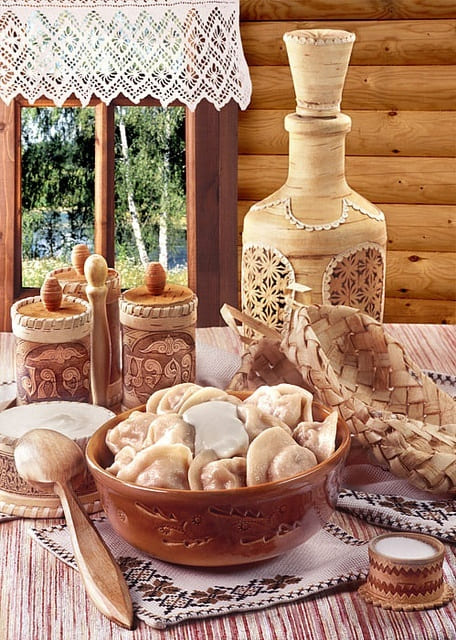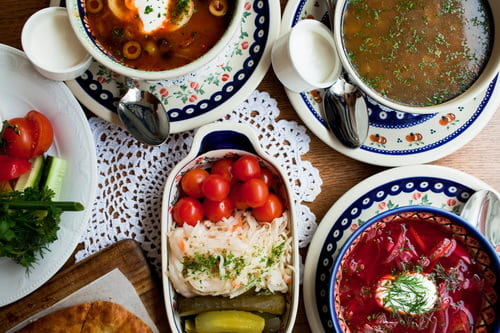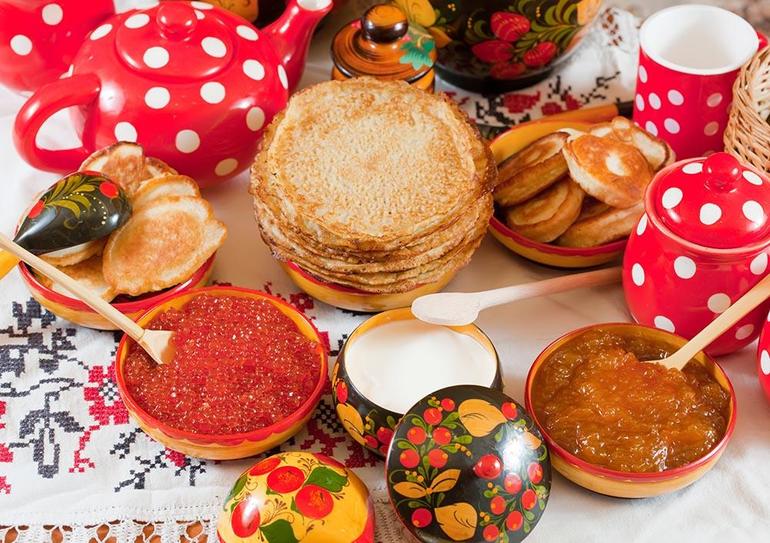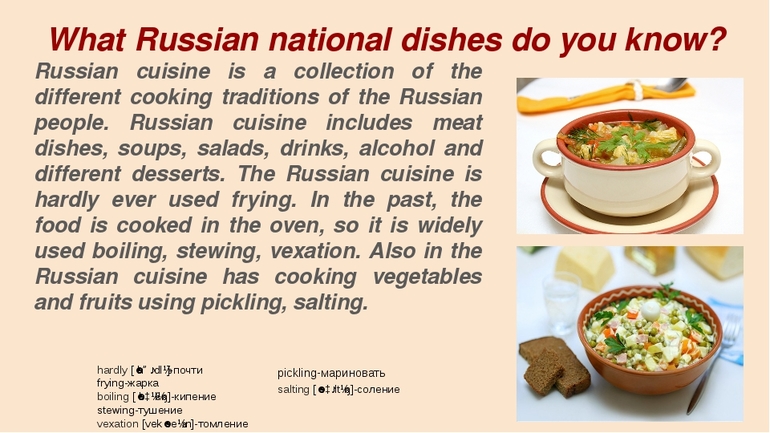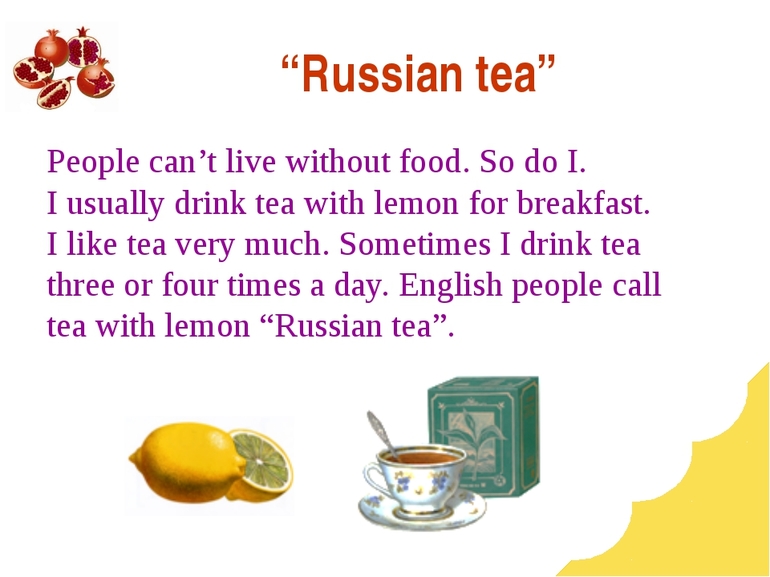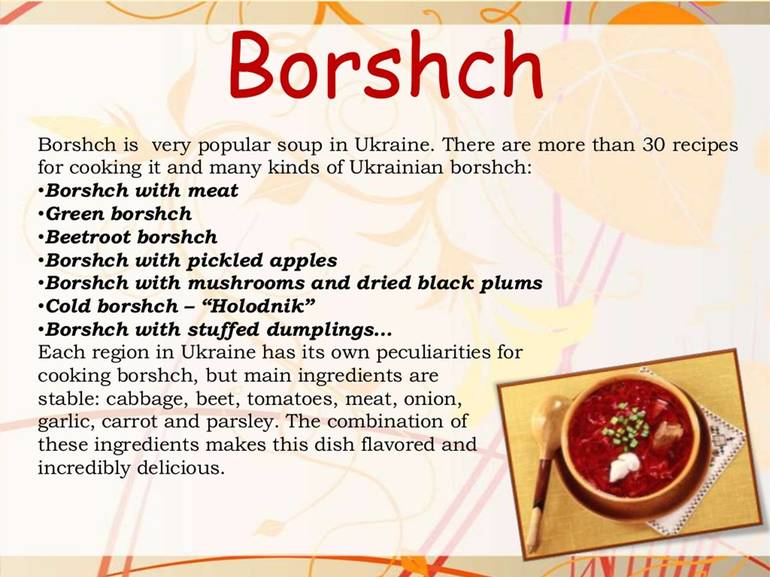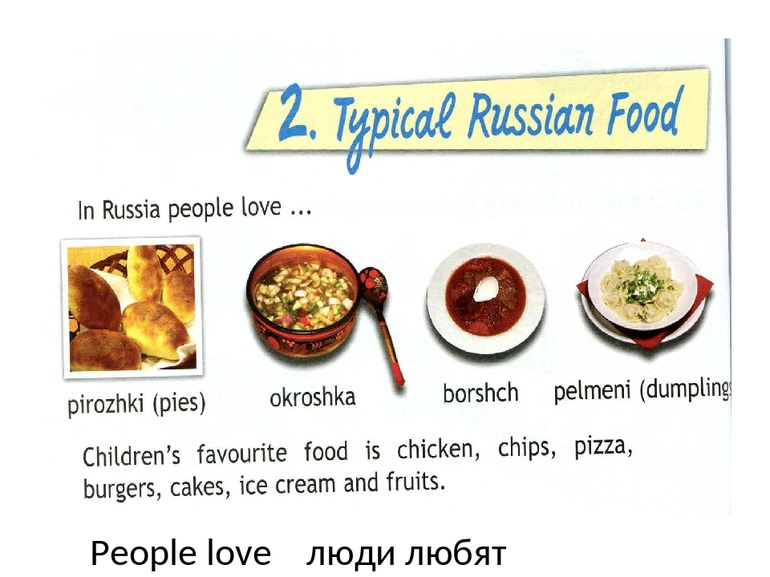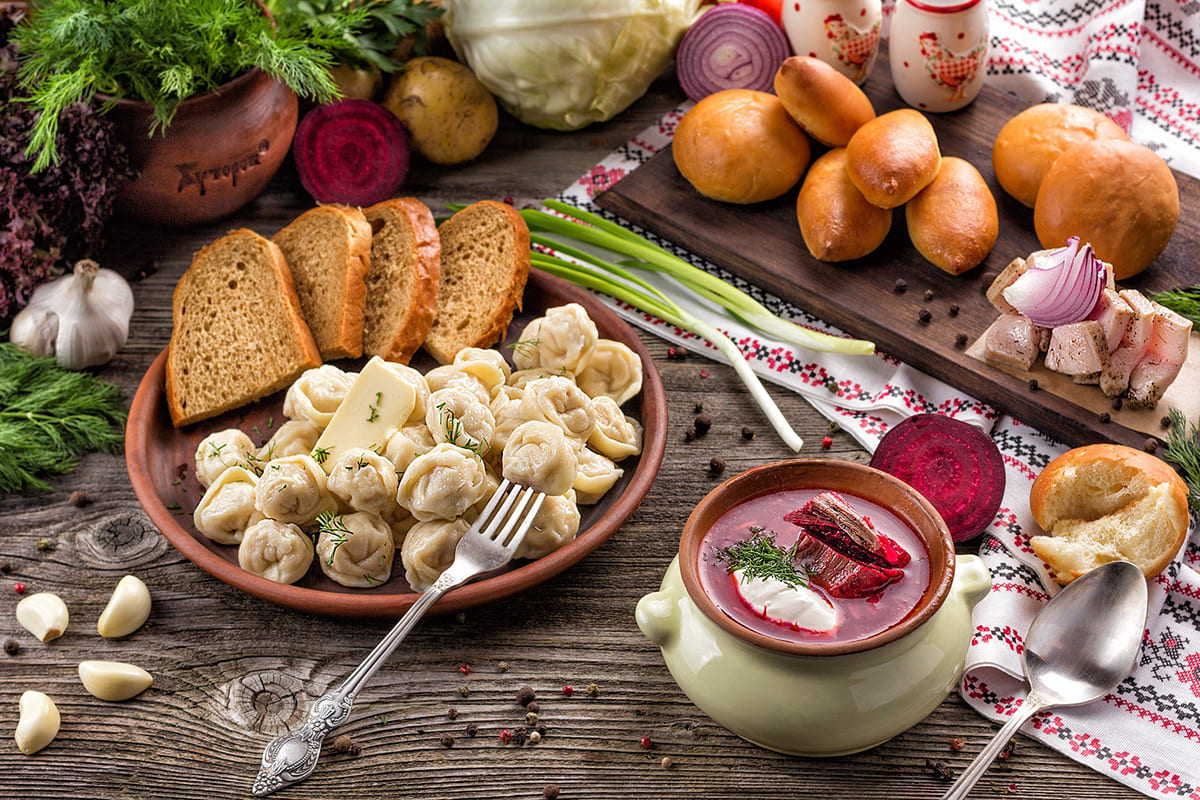Russia is a huge country and that is why Russian cuisine is a rich collection of diverse cooking traditions. Russian food has its own peculiarities due to the country’s severe climate in winter and its forests rich in berries, mushrooms in summer. Traditional Russian dishes are often made of vegetables, different crops, dairy products, fresh-water fish, poultry and meat.
For breakfast Russian people usually have milk porridge, syrniki (cottage cheese pancakes) or an omelette. Lunch is more sufficient and it often consists of a salad, a plate of soup and a main course. For dinner the Russians love fish and meat dishes with garnish (rice, buckwheat, mashed potatoes and stewed cabbage). Traditional pelmeni (meat dumplings), holodetz (meat jelly with pieces of meat, carrot and garlic) or golubtsy (cabbage rolls with minced meat) are special masterpieces of the national culinary art. The Russians also have salads, meat pies, apple pies, vareniki (cottage cheese, cherries or potatoes dumplings) and pancakes for dinner.
The most traditional Russian salads are Olivier, “Herring under a furcoat” and vinegret. All of them are a nourishing mixture of various ingredients such as boiled eggs, boiled vegetables (potatoes, carrots, beetroot), sausage or meat, onions, green peas and cucumbers.
Russian cuisine is famous for the variety of soups: shchi (cabbage soup), borsch (red beetroot soup), ukha (fish soup), solyanka (thick soup made of pickled veggies, meat and sausage) and rassolnik (pickle soup). A plate of hot and spicy soup helps to stay warm during long cold winters. And one of the favourite soups during hot summers is okroshka (cold vegetable and sausage soup based on kvas). All kinds of soups are normally dressed with sour-cream. It is notable that Russian people eat bread with all dishes.
Traditional Russian drinks are hot black tea with jam or honey, compote (stewed fruit drink) and kvas (drink made from rye bread).
The Russians are good at preserving fruits, vegetables and mushrooms. Classic Russian appetizers: pickled cabbage, tomatoes, crispy cucumbers and even apples – are always on a festive table.
Russian people have always been known for their hospitality. They are happy to welcome guests with lavish dinners with abundance of food on the table.
Перевод
Россия – огромная страна, и поэтому русская кухня представляет собой богатую коллекцию разнообразных кулинарных традиций. Русская еда имеет ряд особенностей благодаря жесткому климату страны зимой и его лесам, богатым ягодами и грибами в летнее время. Традиционные русские блюда часто готовят из овощей, различных круп, молочных продуктов, речной рыбы, дичи и мяса.
На завтрак русский народ обычно ест молочную кашу, сырники (оладьи из творога) или омлет. Обед более сытный и нередко состоит из салата, тарелки супа и основного блюда. На ужин русские любят рыбные и мясные блюда с гарниром (рисом, гречкой, картофельным пюре и тушеной капустой). Традиционные пельмени (клецки с мясом), холодец (мясное желе с кусочками мяса, моркови и чеснока) или голубцы (капустные рулеты с мясным фаршем) являются особенными шедеврами национального кулинарного искусства. Русские также едят салаты, пироги с мясом или яблоками, вареники (клецки с творогом, вишней или картофелем) и блины на ужин.
Наиболее традиционными русскими салатами являются Оливье, Сельдь под шубой и винегрет. Все они представляют собой питательную смесь из различных ингредиентов, таких как вареные яйца, отварные овощи (картофель, морковь, свекла), колбаса или мясо, лук, зеленый горошек и огурцы.
Русская кухня известна разнообразием супов: щи (суп с капустой), борщ (красный суп со свеклой), уха (суп с рыбой), солянка (густой суп из маринованных овощей, мяса и колбасных изделий) и рассольник (суп с соленьями). Тарелка горячего пряного супа помогает оставаться в тепле в долгие холодные зимы. А одним из любимых супов в жаркое лето стала окрошка (холодный суп с овощами и колбасой, приготовленный на квасе). Все виды супов обычно заправляются сметаной. Интересно заметить, что русский народ ест хлеб со всеми блюдами.
Традиционными русскими напитками являются горячий черный чай с вареньем или медом, компот (напиток из тушеных фруктов) и квас (напиток, изготовленный из ржаного хлеба).
Русские прекрасно занимаются консервированием фруктов, овощей и грибов. Классические русские закуски: квашеная капуста, маринованные помидоры, хрустящие огурцы и даже яблоки – всегда лежат на праздничном столе.
Русские люди всегда славились своим гостеприимством. Они рады встречать гостей щедрым ужином с изобилием еды на столе.
Тема «Русская кухня» (Russian cuisine) — 4.6 out of
5
based on
54 votes
Представлено сочинение на английском языке Русская еда/ Russian Food с переводом на русский язык.
| Russian Food | Русская еда |
| Every country has its own culture, traditions, holidays and, of course, cuisine. That makes each nation unique and authentic. Learning about Russian cuisine can help to understand better the nature of the country. | У каждой страны своя культура, традиции, праздники и, конечно же, кухня. Это делает каждый народ уникальным и отличным от других. Знание русской кухни может помочь лучше понять сущность страны. |
| Being the largest country by its area, Russia has a diverse cuisine. From ancient times local people cultivated the land, fished, baked bread, gathered herbs, smoked meat, preserved fruit and vegetables, made wine and kept bee-hives. These traditions are being successfully passed from generation to generation. The best recipes have been recorded in special cook books. Russian food is considered to be diverse, tasteful and healthy. | Будучи самой большой страной по площади, Россия имеет разнообразную кухню. С древних времен местные жители возделывали землю, ловили рыбу, пекли хлеб, собирали травы, коптили мясо, консервировали фрукты и овощи, делали вино и заводили улья. Эти традиции успешно передаются из поколения в поколение. Лучшие рецепты были записаны в специальных поваренных книгах. Русская кухня считается разнообразной, вкусной и полезной для здоровья. |
| Some of my favourite national dishes are borsch, cabbage rolls, pancakes with jam, vinaigrette, kvass and okroshka. | К некоторым из моих любимых национальных блюд относятся борщ, голубцы, блинчики с джемом, винегрет, квас и окрошка. |
| Borsch is a beetroot soup, which contains many other vegetables: potatoes, carrots, onions, cabbage. Every housewife has her own recipe of borsch. | Борщ – это свекольный суп, в котором содержится много и других овощей: картофель, морковь, лук, капуста. У каждой хозяйки свой рецепт борща. |
| Cabbage rolls are very tasty. They can be stuffed with meat, rice, herbs and spices. | Голубцы очень вкусные. Они могут быть с начинкой из мяса, риса, зелени и специй. |
| Russian pancakes are fantastic. They are flat cakes in the shape of sun served with sour cream or cottage cheese. I personally love them with jam or condensed milk. | Русские блины превосходны. Это плоские лепешки в форме солнца, которые подаются со сметаной или творогом. Лично я люблю их есть с вареньем или со сгущенкой. |
| Vinaigrette is a traditional Russian salad made of cooked beetroot. Other vegetables in it include potatoes, carrots, onion, green peas or beans. People add sauerkraut or pickles to make it more savory. | Винегрет – это традиционный русский салат из вареной свеклы. Другие овощи в нем включают картофель, морковь, лук, зеленый горошек или фасоль. Люди добавляют туда квашеную капусту или соленые огурцы, чтобы сделать его более аппетитным. |
| Kvass is a cold fermented drink made of rye bread. It is especially popular in summertime. It is one of the ingredients of cold Russian soup okroshka. However, some people make okroshka from a fermented milk drink, called kefir. | Квас – это холодный ферментированный напиток, изготовленный на основе ржаного хлеба. Он особенно популярен в летнее время. Он является одним из компонентов холодного русского супа окрошка. Однако некоторые люди готовят окрошку из кисломолочного напитка под названием кефир. |
План рассказа на английском «Блюда русской кухни»
Любое эссе начинается с вводных слов о предложенной теме. Далее следует раскрыть предмет обсуждения и подвести итоги. План сочинения выглядит так:
- Введение.
- Основная часть.
- Итог.
А также перед написанием можно составить перечень кушаний, которые следует описать. Это могут быть:
- варенье;
- щи;
- борщ;
- пироги;
- кулебяка;
- пельмени;
- вареники;
- оливье;
- говяжий язык и другие.
Эссе на тему «Русская еда»
Во время разработки вариантов экзаменов педагогический коллектив составителей выбирает распространённые темы для письма (последнего задания на ЕГЭ по английскому языку).
Тема еды встречается в довольно простых вариантах. Ниже представлены 3 топика с переводом «Русская еда» для сочинения на английском языке.
Everyday food in Russia
В этом топике описываются повседневные блюда и основные приёмы пищи.
|
Russians, as you know, like to eat delicious food. It may not always be the right and healthy food, but it is very diverse and unusual for foreigners. Mostly in Russia, women cook and pass their favorite recipes to their daughters by inheritance. Most Russians eat three meals a day-Breakfast, lunch, and dinner. Of course, everyone has their own tastes. Usually, the dishes alternate and are chosen according to the mood. For Breakfast, Russians choose fast food, but do not confuse it with American fast food. It usually includes either sandwiches with a drink (tea or coffee), or an omelet, or porridge. For a traditional lunch, 3 dishes are prepared. First course — soup (borsch, Solyanka soup or grub). The second — meat or fish and garnish (rice, potatoes, pasta or buckwheat). The third — compote or juice. Usually Russians have dinner at home, but sometimes in cafes. There are no specific dishes, everyone chooses what they like — vegetables, cereals, pizza, yogurt or cottage cheese. I can talk about Russian food endlessly. Not everyone likes it, but every kitchen has its own connoisseurs. |
Русские, как известно, любят вкусно покушать. Пусть это не всегда правильная и полезная пища, но очень разнообразная и необычная для иностранцев. В основном в России готовят женщины и передают излюбленные рецепты дочерям по наследству. Большинство русских едят три раза в день — завтракают, обедают и ужинают. Конечно, у каждого свои вкусы. Обычно блюда чередуются и выбираются по настроению. На завтрак русские делают блюда быстрого приготовления, но не стоит путать с американским фаст-фудом. Он включает или бутерброды с напитком (чаем или кофе), или омлет, или же кашу. На традиционный обед готовятся 3 блюда. Первое — суп (борщ, щи, солянка или харчо). Второе — мясо или рыба и гарнир (рис, картофель, макароны или гречка). Третье — компот или морс. Обычно русские ужинают дома, но иногда в кафе. Здесь нет определённых блюд, каждый выбирает то, что ему по вкусу — овощи, хлопья, пицца, йогурт или творог. О русской еде можно говорить бесконечно. Не всем она по нраву, но у каждой кухни находятся свои ценители. |
Russian traditional dishes
В каждой стране есть свои классические рецепты, которые формируются под воздействием географического положения, климата, менталитета и обычаев народа.
В сочинении на английском языке «Традиционные блюда России» содержится описание устоявшихся русских кушаний, от которых иностранцы приходят в шок.
|
The main feature of Russian cuisine can be considered originality and uniqueness. Tourists are often perplexed when trying our dishes. What kind of food so frighten visitors? Wobbler ranks first in the rating of the most terrible dishes in the understanding of the British and Americans. They do not recognize other parts of the animal’s body other than meat. Also, in their understanding, jelly is a dessert, not a second course, and certainly not an appetizer. Borscht is a dish that almost all foreigners like. In the soup, which is based on beets, add a large amount of meat and stewed vegetables. Pancakes are a native Russian dish. These are flatbreads made on the basis of milk and flour. They can be either salted (meat, cheese or caviar) or sweet (jam or syrup). In English — speaking countries, there is a similar dish-pancake. Caviar on the contrary is very popular with tourists from other countries. This is a salty dish that is served on a piece of bread with butter. Russia is rich in sauerkraut, meat and fish dishes that are worth trying at least once in your life. |
Главной особенностью русской кухни можно считать самобытность и неповторимость. Туристы часто недоумевают, пробуя наши блюда. Какие же кушанья так пугают приезжих? Холодец занимает первое место в рейтинге самых ужасных блюд в понимании англичан и американцев. Они не признают другие части тела животного, кроме мяса. Также в их понимании желе — это десерт, а не второе блюдо, и уж тем более не закуска. Борщ — это блюдо, которое нравится почти всем иностранцам. В суп, в основе которого свёкла, добавляют большое количество мяса и тушёных овощей. Блины — исконно русское кушанье. Это такие лепёшки, сделанные на основе молока и муки. Они могут быть как с солёной начинкой (мясо, сыр или икра), так и со сладкой (варенье или сироп). В англоязычных странах есть похожее блюдо — панкейки. Икра, наоборот, очень нравится туристам из других стран. Это солёное блюдо, которое подаётся на кусочке хлеба с маслом. Россия богата квашеными, мясными и рыбными блюдами, которые хоть раз в жизни точно стоит попробовать. |
Russian cuisine
Русская кухня — это очень ёмкое и широкое понятие. Она включает в себя всевозможные соленья, квашенья, супы, каши и различную выпечку.
В тексте на английском языке по теме «Блюда русской кухни» упоминаются самые популярные яства России.
| Russia is a great country. Every year its attractions attract tourists. Russian national cuisine at the same time fascinates and terrifies visitors. One of the famous dishes of Russian cuisine is Olivier salad. It includes boiled potatoes, sausage, eggs, green peas and mayonnaise. This dish is also popular in Iran, Israel, Mongolia and Latin America. Okroshka is a cold soup that Russians fill with kefir or kvass. Cooking it is very easy, because all the products match the ingredients of Olivier (except mayonnaise) and there is in the refrigerator of every person. Pelmeni are considered the heart of Russian cuisine. They are to the taste of almost everyone. Dumplings are similar to manti, but are cooked in boiling water. These are small pies made of dough with meat filling. If you change the filling to berry or cottage cheese, you will get another Russian dish called vareniki. If you are going to travel to Russia, you should definitely try dishes, described in this topic. | Россия — великая страна. С каждым годом её достопримечательности привлекают туристов. Русская национальная кухня одновременно восхищает и ужасает приезжих. Одним из известных блюд русской кухни является салат оливье. В его состав входит варёный картофель, колбаса, яйца, зелёный горошек и майонез. Это блюдо также популярно в Иране, Израиле, Монголии и Латинской Америке. Окрошка — это холодный суп, который русские заправляют кефиром или квасом. Приготовить ее очень легко, ведь все продукты совпадают с ингредиентами оливье (кроме майонеза) и есть в холодильнике почти каждого человека. Пельмени считаются сердцем русской кухни. Они по вкусу почти всем. Пельмени похожи на манты, но готовятся в кипящей воде. Это такие маленькие пирожочки из теста с начинкой из мяса. Если поменять начинку на ягодную или творожную, то получится другое русское блюдо под названием вареники. Если вы собираетесь поехать в Россию, то обязательно попробуйте блюда, описанные в этом сочинении. |
В мире насчитывается более семи тысяч языков. Самый популярный из них — английский. Несмотря на красоту и любовь к русскому язык, филологи утверждают, что самым богатым языком является именно английский. Основные знания этого языка крайне необходимы представителям многих профессий, так как более половины справочных материалов, книг и трудов великих учёных написаны на английском.
Дорогой ученик! В этом материале опубликованы русские блюда на английском языке. Под английским текстом есть перевод на русский язык.
Russian Cuisine
Olivier salad |
|
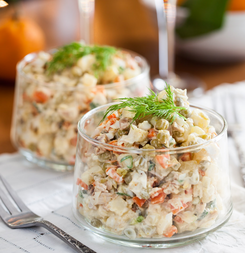 |
Olivier salad is a traditional salad in Russian cuisine, which is also popular in other post-Soviet countries, many European countries, Iran, Israel, Mongolia and also throughout Latin America. In different modern recipes, it is usually made with diced boiled potatoes, carrots, green peas, eggs, diced boiled chicken (or sometimes ham) with salt, pepper, dressed with mayonnaise. |
Okroshka |
|
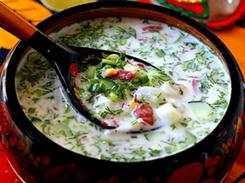 |
Okroshka is a cold soup of Russian origin. The classic soup is a mix of mostly raw vegetables (like cucumbers, radishes and spring onions), boiled potatoes, eggs, and a cooked meat with kvass. Later versions that first appeared in Soviet times use kefir, or mineral water instead of kvass. |
Varenye |
|
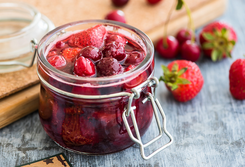 |
Varenye or varenie is a popular dessert, widespread in Eastern Europe (Russia, Ukraine, Belarus). It is made by cooking berries, fruits, or more rarely nuts, vegetables, or flowers, in sugar syrup. |
Blini |
|
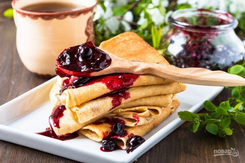 |
Blini are thin, flat cakes prepared from batter and cooked on a hot frying pan – first on one side and then flipped to cook on the other side. Blini are eaten with mushrooms, meat, jam or sour cream. |
Pelmeni |
|
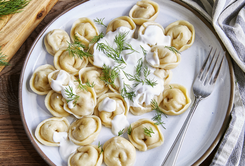 |
Pelmeni are considered as the heart of Russian cuisine. They consist of a filling wrapped in thin dough. The filling can be minced meat or fish. Pelmeni are often served with sour cream (smetana). |
Vinegret |
|
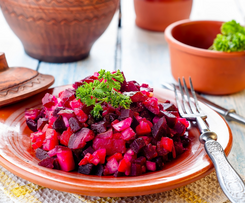 |
Vinegret is a salad in Russian cuisine which is also popular in other post-Soviet states. It includes diced cooked vegetables (beetroots, potatoes, carrots), chopped onions and sauerkraut. Other ingredients, such as green peas or beans, are sometimes also added. |
Блюда русской кухни
Салат Оливье |
|
 |
Салат Оливье – традиционный салат русской кухни, который также популярен в других постсоветских странах, многих странах Европы, Иране, Израиле, Монголии, а также в Латинской Америке. В разных современных рецептах салат Оливье обычно готовят из нарезанного вареного картофеля, моркови, зеленого горошка, яиц, вареной курицы (или иногда ветчины) с солью, перцем, и все это заправляется майонезом. |
Окрошка |
|
 |
Окрошка – это холодный суп русского происхождения. Классическая окрошка готовится в основном из сырых овощей (огурцов, редиса, зеленого лука), вареного картофеля, яиц и вареного мяса с квасом. В более поздних рецептах, которые впервые появились во времена СССР, используется кефир или вода вместо кваса. |
Варенье |
|
 |
Варенье – это популярный десерт, широко распространенный в Восточной Европе (Россия, Украина, Беларусь). Его получают путем варки в сахаре фруктов, ягод или реже орехов, овощей, цветов. |
Блины |
|
 |
Блины – это тонкие, плоские мучные изделия, которые готовят из взбитого жидкого теста и обжаривают на горячей сковороде – сначала на одной стороне, а затем переворачивают на другую. Блины едят с грибами, мясом, вареньем или сметаной. |
Пельмени |
|
 |
Пельмени считаются сердцем русской кухни. Они состоят из начинки, обернутой в тонкое тесто. В качестве начинки может быть мясной фарш или рыба. Пельмени часто подают со сметаной. |
Винегрет |
|
 |
Винегрет – это салат русской кухни, который также популярен и в других постсоветских странах. Его готовят из нарезанных вареных овощей (свеклы, картофеля, моркови), нарезанного лука и квашеной капусты. Также могут быть добавлены и другие ингредиенты, например, зеленый горошек или фасоль. |
►Russian Culture ►Russian Cuisine
Russian cuisine often gets a bad press for being bland and stodgy but this reputation is undeserved. Russian cuisine has some delicious dishes which you should definitely try when visiting the country. Russian cuisine has absorbed European, eastern, southern and northern influences and it can vary from region to region, even in respect of the same dish. Russian food tends to be very heavy with lots of fat due to the use of oil, butter, sour cream and mayonnaise. This can be explained by the traditional need of calories during Russia’s harsh winters. Pickled foods also feature heavily, again due to the winter and the need to preserve fresh products. Traditionally Russian food was cooked in special ovens which even today are still found all over Russian villages. Below we provide you with a brief guide of some of the dishes you will see on a traditional Russian menu.
Zakuski / Hors d’oeuvre (Закуски)
A special feature of Russian cuisine is its wide array of hors d’oeuvre. These can be made out of vegetables, meat or fish and can be ordered as a started or just to have on the table throughout the dinner, as they are often eaten after a shot of vodka is drunk.
Caviar (Икра)
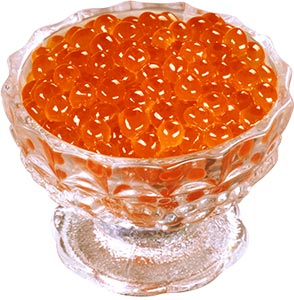
Kholodets (Холодец)
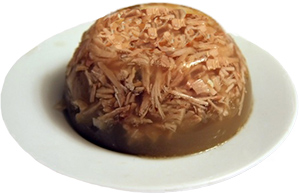
Pies (Пирожки)
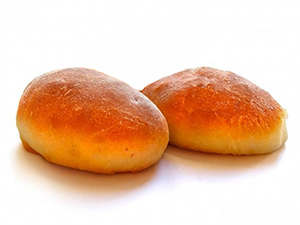
Julienne (Жюльен)
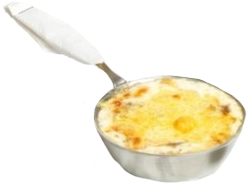
Salads (Салаты)
Russians tend to prefer their salads heavy with lots of mayonnaise, although European style olive oil and vinegar-based salads, such as caesar salads and greek salads, can now be found alongside the tradition Russian salads on most menus across the country. Russian salads with fresh vegetables often use sunflower oil rather than olive oil.
Olivier (Оливье)
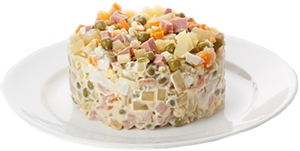
Vinegret (Винегрет)
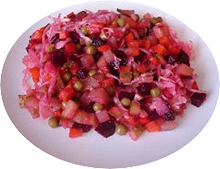
Herring In a Fur Coat (Селёдка под шубой)
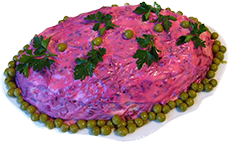
Korean Carrots (Морковь по-корейски)
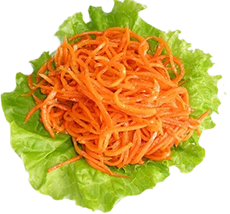
Breakfast Dishes (Завтраки)
Russian breakfasts at restaurants and hotels can vary and sometimes dishes more resembling dinner such as sausages and pasta can be served. The dishes mentioned below though make a delicious start to the day.
Kasha (Каша)
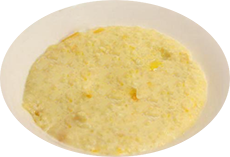
Blini (Блины)

Syrniki (Сырники)
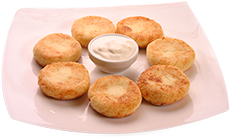
Oladi (Оладьи)

Soups (Супы)
Soup is an important dish in Russia and most Russian meals start with soup. In fact the common type of service where various courses (salad, soup, main, desert) are brought sequentially was originally known as Service à la russe (‘service in the Russian style) and previously in Europe all dishes were placed on the table at once.
Borsch (Борщ)
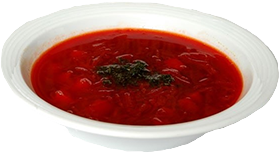
Schi (Щи)
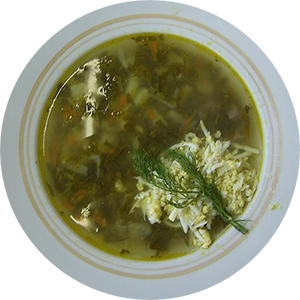
Ukha (Уха)
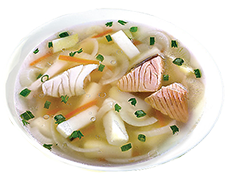
Okroshka (Окрошка)
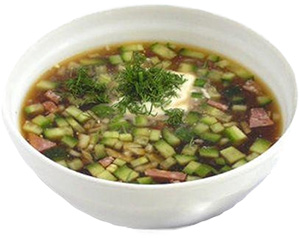
Solyanka (Солянка)
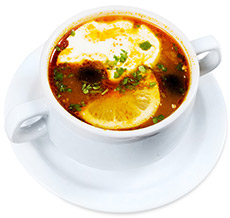
Rassolnik (Рассольник)
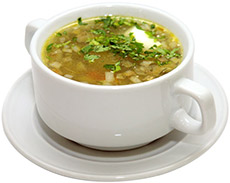
Main courses (Основные блюда)
Most Russian main courses consist of meat and although the situation is improving, vegetarians still don’t always have a lot of choice when order food in restaurants. The most popular meats in Russia are pork, beef, chicken and lamb. However you can also sometimes find on the menu rabbit, duck, goose and in some specialist restaurants even wild boar, moose, venison and bear. In restaurants you normally need to choose a side dish separately to your main. Popular side dishes include fried potato, mashed potatoes, chips, rice, buckwheat or macaroni. Upon arriving in Russia it won’t take long for you to notice that dill is a popular herb in Russian cuisine.
Shashlyk (Шашлык)
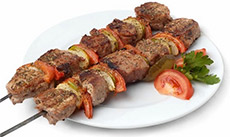
Cutlets (Котлеты)
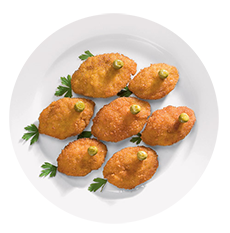
Escalopes (Эскалопы)
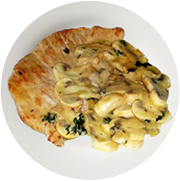
Beef Stroganov (Бефстроганов)
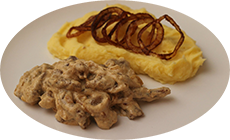
Zharkoe (Жаркое)
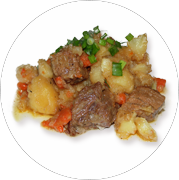
Pelmeni (Пельмени)
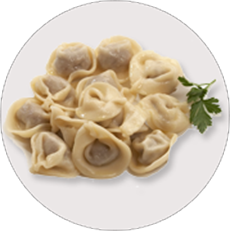
Vareniki (Вареники)
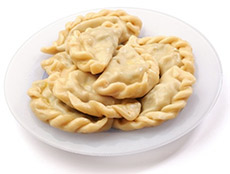
Manty (Манты)
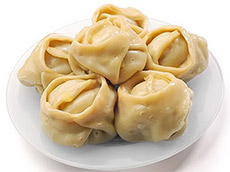
Golubtsy (Голубцы)
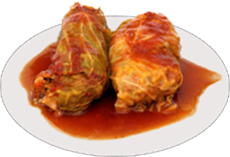
Drinks (Напитки)
Although in Russian you can now get hold of most of the brands of soft drinks and alcohol you find in the West, there are some drinks that are specialities of Russia. The most popular non-alcoholic drink in Russia is probably tea and most gatherings will probably end with a cup of tea accompanied with something sweet.
Vodka (Водка)

Mors (Морс)
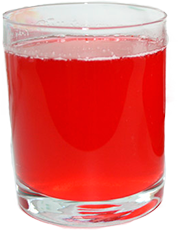
Kompot (Компот)
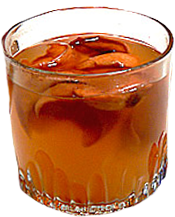
Kvas (Квас)
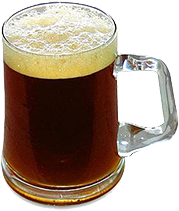
Medovukha (Медовуха)

Sbiten (Сбитень)
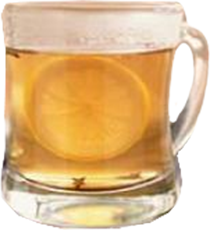
Kefir (Кефир)
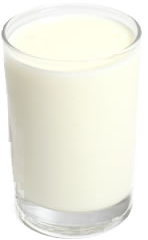
Kisel (Кисель)
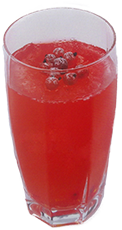
Baikal (Байкал)

►Russian Culture ►Russian Cuisine
с переводом на русский язык |
|
Russian Meals |
Русская еда |
|
Russian meals are part of Russian traditional cuisine. Long winters and vast forests affected the food that our ancestors cooked. The specialties of the cuisine are a variety of hot dishes, such as soups and cereals. Also, in order to survive the cold season, the Russian people filled their cellars with all kinds of conservation. |
Русские блюда входят в состав русской традиционной кухни. Долгая зима и обширные леса повлияли на ту еду, которую готовили наши предки. Особенностями кухни являются разнообразные горячие блюда, например, супы и каши. Также, для того, чтобы пережить холодное время года, русские люди забивали свои погреба всевозможной консервацией. |
|
But the world does not stand still. The country is developing, and the cuisine is developing with it. Russia gradually moved away from the estate system. And after the revolution and the foundation of the Soviet Union, dishes from other republics firmly entered the traditional Russian cuisine. |
Но, мир не стоит на месте. Страна развивается, и кухня развивается вместе с ней. Россия постепенно отходила от сословного строя. А после революции и основания Советского союза, в традиционную русскую кухню прочно вошли блюда других республик. |
|
However, despite the multinational nature of our country, many of truly Russian meals are still popular today. One of these dishes is dumplings (or pelmeni). In every country you can find dough in which some kind of filling is placed. Gyoza, manti, khinkali are brothers from different mothers. But our Russian pelmeni have been known since the 14th century. Their homeland is Ural. |
Однако, несмотря на многонациональность нашей страны, многие истинно русские блюда популярны и по сей день. Одним из таких блюд являются пельмени. В каждой стране можно найти тесто, в которое помещают какую-либо начинку. Гёдзы, манты, хинкали – братья от разных матерей. Но наши, русские, пельмени известны ещё с 14 века. Их родина – Урал. |
|
Another traditional dish is jellied meat (kholodets). It usually causes a little shock to foreigners. In truth, even many Russians are disgusted by it. But anyway, on almost every Russian New Year’s table you can find jelly with pieces of meat, carrots and parsley. |
Ещё одним традиционным блюдом является холодец. Он, как правило, вызывает небольшой шок у иностранцев. По правде говоря, он вызывает отвращение даже у многих русских. Но всё равно, почти на каждом русском новогоднем столе можно обнаружить желе с кусками мяса, морковкой и петрушкой. |
|
«You must spoil before you spin» («The first pancake is lumpy»). This proverb is almost as old as the dish associated with it. Pancakes have traditionally been baked in an oven since the 9th century. The ingredients are very simple, but making a quality pancake is an art. And every housewife has her secrets. |
«Первый блин комом». Эта пословица почти такая же старая, как и блюдо, которое с ней связано. Блины традиционно выпекались в печи, начиная с 9 века. Ингредиенты – очень просты, но сделать качественный блин – целое искусство. И у каждой хозяйки свои секреты. |
|
I can talk a lot about the diversity of Russian meals. But it will be a very long story. |
О разнообразии Русской еды можно говорить много. Но это будет очень долгая история. |
метки: Around, Блюдо, Русская, Перевод, Russian, Россия, Include, Traditional
- Основная часть.
- Итог.
А также перед написанием можно составить перечень кушаний, которые следует описать. Это могут быть:
- варенье;
- щи;
- борщ;
- пироги;
- кулебяка;
- пельмени;
- вареники;
- оливье;
- говяжий язык и другие.
Эссе на тему «Русская еда»
Во время разработки вариантов экзаменов педагогический коллектив составителей выбирает распространённые темы для письма (последнего задания на ЕГЭ по английскому языку).
Тема еды встречается в довольно простых вариантах. Ниже представлены 3 топика с переводом «Русская еда» для сочинения на английском языке.
Everyday food in Russia
В этом топике описываются повседневные блюда и основные приёмы пищи .
|
Russians, as you know, like to eat delicious food. It may not always be the right and healthy food, but it is very diverse and unusual for foreigners. Mostly in Russia, women cook and pass their favorite recipes to their daughters by inheritance. Most Russians eat three meals a day-Breakfast, lunch, and dinner. Of course, everyone has their own tastes. Usually, the dishes alternate and are chosen according to the mood. For Breakfast, Russians choose fast food, but do not confuse it with American fast food. It usually includes either sandwiches with a drink (tea or coffee), or an omelet, or porridge. For a traditional lunch, 3 dishes are prepared. First course — soup (borsch, Solyanka soup or grub).
The second — meat or fish and garnish (rice, potatoes, pasta or buckwheat). The third — compote or juice. Usually Russians have dinner at home, but sometimes in cafes. There are no specific dishes, everyone chooses what they like — vegetables, cereals, pizza, yogurt or cottage cheese. I can talk about Russian food endlessly. Not everyone likes it, but every kitchen has its own connoisseurs. |
Русские, как известно, любят вкусно покушать. Пусть это не всегда правильная и полезная пища, но очень разнообразная и необычная для иностранцев. В основном в России готовят женщины и передают излюбленные рецепты дочерям по наследству. Большинство русских едят три раза в день — завтракают, обедают и ужинают. Конечно, у каждого свои вкусы. Обычно блюда чередуются и выбираются по настроению. На завтрак русские делают блюда быстрого приготовления, но не стоит путать с американским фаст-фудом. Он включает или бутерброды с напитком (чаем или кофе), или омлет, или же кашу. На традиционный обед готовятся 3 блюда. Первое — суп (борщ, щи, солянка или харчо).
Второе — мясо или рыба и гарнир (рис, картофель, макароны или гречка). Третье — компот или морс. Обычно русские ужинают дома, но иногда в кафе. Здесь нет определённых блюд, каждый выбирает то, что ему по вкусу — овощи, хлопья, пицца, йогурт или творог. О русской еде можно говорить бесконечно. Не всем она по нраву, но у каждой кухни находятся свои ценители. |
Russian traditional dishes
В каждой стране есть свои классические рецепты, которые формируются под воздействием географического положения, климата, менталитета и обычаев народа.
В сочинении на английском языке «Традиционные блюда России» содержится описание устоявшихся русских кушаний, от которых иностранцы приходят в шок.
|
The main feature of Russian cuisine can be considered originality and uniqueness. Tourists are often perplexed when trying our dishes. What kind of food so frighten visitors? Wobbler ranks first in the rating of the most terrible dishes in the understanding of the British and Americans. They do not recognize other parts of the animal’s body other than meat. Also, in their understanding, jelly is a dessert, not a second course, and certainly not an appetizer. Borscht is a dish that almost all foreigners like. In the soup, which is based on beets, add a large amount of meat and stewed vegetables. Pancakes are a native Russian dish. These are flatbreads made on the basis of milk and flour. They can be either salted (meat, cheese or caviar) or sweet (jam or syrup).
In English — speaking countries, there is a similar dish-pancake. Caviar on the contrary is very popular with tourists from other countries. This is a salty dish that is served on a piece of bread with butter. Russia is rich in sauerkraut, meat and fish dishes that are worth trying at least once in your life. |
Главной особенностью русской кухни можно считать самобытность и неповторимость. Туристы часто недоумевают, пробуя наши блюда. Какие же кушанья так пугают приезжих? Холодец занимает первое место в рейтинге самых ужасных блюд в понимании англичан и американцев. Они не признают другие части тела животного, кроме мяса. Также в их понимании желе — это десерт, а не второе блюдо, и уж тем более не закуска. Борщ — это блюдо, которое нравится почти всем иностранцам. В суп, в основе которого свёкла, добавляют большое количество мяса и тушёных овощей. Блины — исконно русское кушанье. Это такие лепёшки, сделанные на основе молока и муки. Они могут быть как с солёной начинкой (мясо, сыр или икра), так и со сладкой (варенье или сироп).
В англоязычных странах есть похожее блюдо — панкейки. Икра, наоборот, очень нравится туристам из других стран. Это солёное блюдо, которое подаётся на кусочке хлеба с маслом. Россия богата квашеными, мясными и рыбными блюдами, которые хоть раз в жизни точно стоит попробовать. |
Russian cuisine
Русская кухня — это очень ёмкое и широкое понятие. О на включает в себя всевозможные соленья, квашенья, супы, каши и различную выпечку.
В тексте на английском языке по теме «Блюда русской кухни» упоминаются самые популярные яства России .
| Russia is a great country. Every year its attractions attract tourists. Russian national cuisine at the same time fascinates and terrifies visitors. One of the famous dishes of Russian cuisine is Olivier salad. It includes boiled potatoes, sausage, eggs, green peas and mayonnaise. This dish is also popular in Iran, Israel, Mongolia and Latin America. Okroshka is a cold soup that Russians fill with kefir or kvass. Cooking it is very easy, because all the products match the ingredients of Olivier (except mayonnaise) and there is in the refrigerator of every person. Pelmeni are considered the heart of Russian cuisine. They are to the taste of almost everyone. Dumplings are similar to manti, but are cooked in boiling water. These are small pies made of dough with meat filling. If you change the filling to berry or cottage cheese, you will get another Russian dish called vareniki. If you are going to travel to Russia, you should definitely try dishes, described in this topic. | Россия — великая страна. С каждым годом её достопримечательности привлекают туристов. Русская национальная кухня одновременно восхищает и ужасает приезжих.
Одним из известных блюд русской кухни является салат оливье. В его состав входит варёный картофель, колбаса, яйца, зелёный горошек и майонез. Это блюдо также популярно в Иране, Израиле, Монголии и Латинской Америке. Окрошка — это холодный суп, который русские заправляют кефиром или квасом. Приготовить ее очень легко, ведь все продукты совпадают с ингредиентами оливье (кроме майонеза) и есть в холодильнике почти каждого человека. Пельмени считаются сердцем русской кухни. Они по вкусу почти всем. Пельмени похожи на манты, но готовятся в кипящей воде. Это такие маленькие пирожочки из теста с начинкой из мяса. Если поменять начинку на ягодную или творожную, то получится другое русское блюдо под названием вареники. Если вы собираетесь поехать в Россию, то обязательно попробуйте блюда, описанные в этом сочинении. |
В мире насчитывается более семи тысяч языков. Самый популярный из них — английский. Несмотря на красоту и любовь к русскому язык, филологи утверждают, что самым богатым языком является именно английский. Основные знания этого языка крайне необходимы представителям многих профессий, так как более половины справочных материалов, книг и трудов великих учёных написаны на английском.
Russian cuisine
Each nation has its culinary traditions and dishes that people consider the most delicious in the world. Traditional Russian first hot dishes are “ukha” and “shchi”. “Ukha” or fish soup is one of the most ancient dishes that was prepared by the ancient Slavs since in those days there were lots of fish in rivers and lakes. “Shchi” (cabbage soup) appeared later. Scientists talk about the 9th century AD when peasants began to grow cabbage. Cabbage soup was first prepared in a clay pot, and over time, in a cast-iron one and certainly in a Russian stove.
Another dish that comes to mind is “bliny” (pancakes). The batter is poured into a pan and fried on both sides. Pancakes are eaten with sour cream or jam, and you can also cook different toppings for them. This dish is so loved by the Russian people that there is even a holiday, Maslenitsa, which lasts a whole week, during which pancakes are the main food. This is a pagan holiday of farewell to winter on the one hand, and on the other, preparation for Lent, when meat and dairy products cannot be eaten for the next 40 days.
Moms in many Russian families prepare pies, both fried and baked. The fillings can be any: minced meat, egg and green onions, cabbage, fruits, and jam. Pies, as a rule, are small dough products. But some craftswomen know how to cook kulebyaka. This is a traditional Russian pie, in which there are several types of stuffing, where each is separated by a thin pancake so as not to mix. My grandmother sometimes cooks kulebyaka on holidays, and this huge pie serves as a real table decoration.
Among the sweet dishes that are originally Russian can be called various “kiseli” (jelly). In modern times, it is cooked from various berries with the addition of starch and sugar. And in ancient Russia, oats, and cranberries were used.
But it’s better not to talk about dishes, you need to try them, so bon appetit (enjoy your meal).
Перевод
Каждый народ имеет свои кулинарные традиции и блюда, которые считает самыми вкусными в мире. Традиционными русскими первыми горячими блюдами считаются уха и щи. Уха или суп из рыбы — одно из самых древних блюд, которое готовили еще древние славяне, благо, в те времена водилось много рыбы в реках и озерах. Щи появились позже. Ученые говорят о 9 веке нашей эры, когда крестьяне начали выращивать капусту. Щи (капустный суп) готовили сначала в глиняном горшке, а со временем и в чугунном и непременно в русской печке.
Другое блюдо, которое приходит на ум, — это блины. Жидкое тесто разливают по сковородке и жарят с обеих сторон. Блины едят со сметаной или вареньем, а также можно готовить к ним разные начинки. Это блюдо настолько любимо русским народом, что даже есть праздник, Масленица, длящийся целую неделю, на протяжении которой блины – основная еда. Это языческий праздник прощания с зимой с одной стороны, а с другой, подготовка к Великому посту, когда ближайшие 40 дней нельзя есть мясные и молочные продукты.
Мамы во многих русских семьях готовят пироги, как жаренные, так и печеные. Начинки могут быть любыми: мясной фарш, яйцо и зеленых лук, капуста, фрукты и варенье. Пироги, как правило, — небольшие изделия из теста. Но есть мастерицы, которые умеют готовить кулебяку. Это традиционный русский пирог, в котором несколько видов начинки, где каждая отделена тонким блинчиком, чтобы не смешиваться. Моя бабушка иногда готовит кулебяку по праздникам, и этот огромным пирог служит настоящим украшением стола.
Среди сладких блюд, являющихся исконно русскими можно назвать различные кисели. В современное время его варят из различных ягод с добавлением крахмала и сахара. А в древней Руси использовали овес и клюкву.
Но о блюдах лучше не говорить, их нужно пробовать, так что приятного аппетита.

